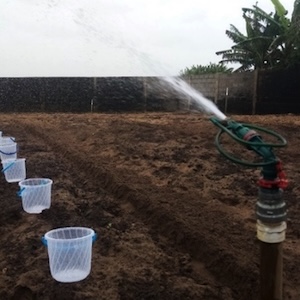Hydraulic performance assessment on dynamic fluidic and complete fluidic sprinklers under indoor and outdoor conditions

All claims expressed in this article are solely those of the authors and do not necessarily represent those of their affiliated organizations, or those of the publisher, the editors and the reviewers. Any product that may be evaluated in this article or claim that may be made by its manufacturer is not guaranteed or endorsed by the publisher.
Authors
Since complete fluidic sprinklers (CFS) cannot function well in low-pressure environments, dynamic fluidic sprinklers (DFS) were developed to address this issue. In 2021, research in the field and laboratory were conducted to examine how well DFS and CFS performed hydraulically in both indoor and outdoor conditions. In this investigation, a Thiess Clima laser precipitation monitor was used to evaluate the droplet size and velocity distribution of two different types of sprinklers indoors. From the findings, DFS velocities ranged from 0.1 to 4 m/s whereas CFS ranged from 0.1 to 5.3 m/s. The maximum frequency value was obtained at velocities of 1 m/s for each combination. The DFS had a slightly greater discharge coefficient and spray pattern than the CFS. The DFS's maximum spray range was 12.2 m, while the CFS's maximum spray range was 10.8 m, with standard deviations of 1.07 and 1.66, respectively. Under high wind speed conditions, the maximum combined Coefficient of Uniformity (CU) of DFS and CFS were 81.1% and 78%, respectively. For a given pressure and sprinkler spacing, DFS delivered higher CU values than CFS, especially while running at low pressure, demonstrating that DFS offered a more favored water distribution pattern at low pressure. At different distances from the sprinkler, the highest application rates for DFS and CFS were 6.7 mm h−1 at 7 m and 6.5 mm h−1 at 7 m, respectively. A comparison of DFS and CFS under hydraulic performance indicated that DFS had a better performance than CFS. The study can serve as a guide for how to conserve water in sprinkler-irrigated fields.
How to Cite

This work is licensed under a Creative Commons Attribution-NonCommercial 4.0 International License.














